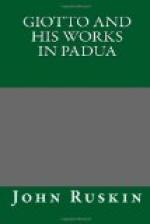“This precious St. Anna had always persevered in the service of God with great wisdom and sincerity; ... and having received Joachim for her husband, was subject to him, and gave him honour and reverence, living in the fear of God. And Joachim having lived with his wife Anna for twenty years, yet having no child, and there being a great solemnity in Jerusalem, all the men of the city went to offer in the temple of God, which Solomon had built; and Joachim entering the temple with (incense?) and other gifts to offer on the altar, and Joachim having made his offering, the minister of the temple, whose name was Issachar, threw Joachim’s offering from off the altar, and drove Joachim out of the temple, saying, ’Thou, Joachim, art not worthy to enter into the temple, seeing that God has not added his blessing to you, as in your life you have had no seed.’ Thus Joachim received a great insult in the sight of all the people; and he being all ashamed, returned to his house, weeping and lamenting most bitterly.” (MS. Harl.)
The Gospel of St. Mary differs from this MS. in its statement of the respective cities of Joachim and Anna, saying that the family of the Virgin’s father “was of Galilee and of the city of Nazareth, the family of her mother was of Bethlehem.” It is less interesting in details; but gives a better, or at least more graceful, account of Joachim’s repulse, saying that Issachar “despised Joachim and his offerings, and asked him why he, who had no children, would presume to appear among those who had: adding, that his offerings could never be acceptable to God, since he had been judged by Him unworthy to have children; the Scripture having said, Cursed is every one who shall not beget a male in Israel.”
Giotto seems to have followed this latter account, as the figure of the high priest is far from being either ignoble or ungentle.
The temple is represented by the two most important portions of a Byzantine church; namely, the ciborium which covered the altar, and the pulpit or reading desk; with the low screen in front of the altar enclosing the part of the church called the “cancellum.” Lord Lindsay speaks of the priest within this enclosure as “confessing a young man who kneels at his feet.” It seems to me, rather, that he is meant to be accepting the offering of another worshipper, so as to mark the rejection of Joachim more distinctly.
* * * * *
II.
JOACHIM RETIRES TO THE SHEEPFOLD.
“Then Joachim, in the following night, resolved to separate himself from companionship; to go to the desert places among the mountains, with his flocks; and to inhabit those mountains, in order not to hear such insults. And immediately Joachim rose from his bed, and called about him all his servants and shepherds, and caused to be gathered together all his flocks, and goats, and horses, and oxen, and what other beasts he had, and went with them and with the shepherds into the hills; and Anna his wife remained at home disconsolate, and mourning for her husband, who had departed from her in such sorrow.” (MS. Harl.)




